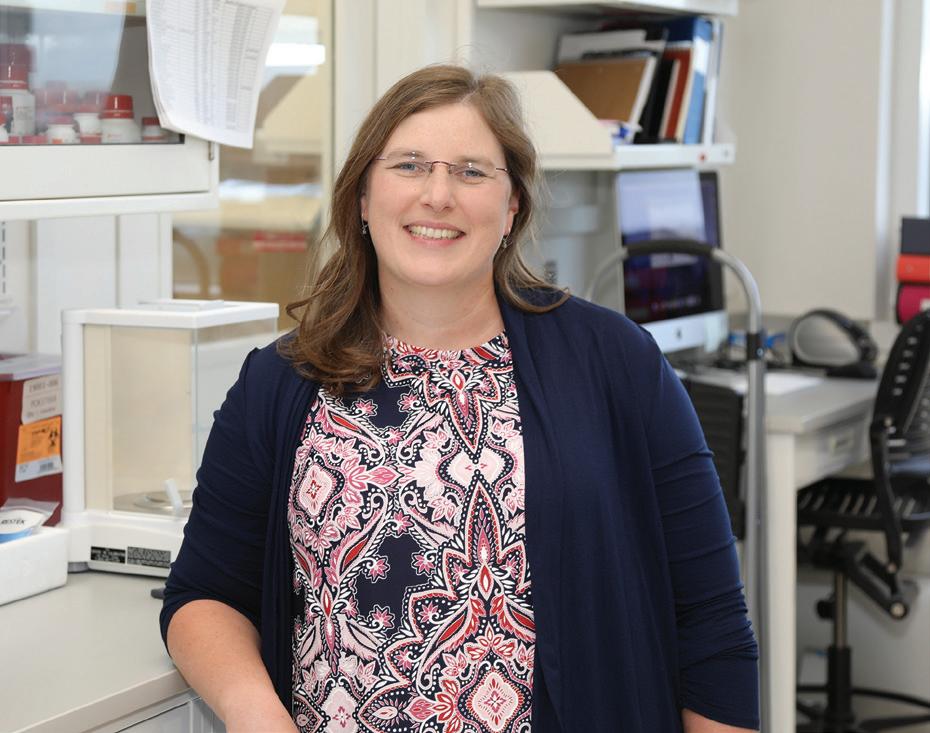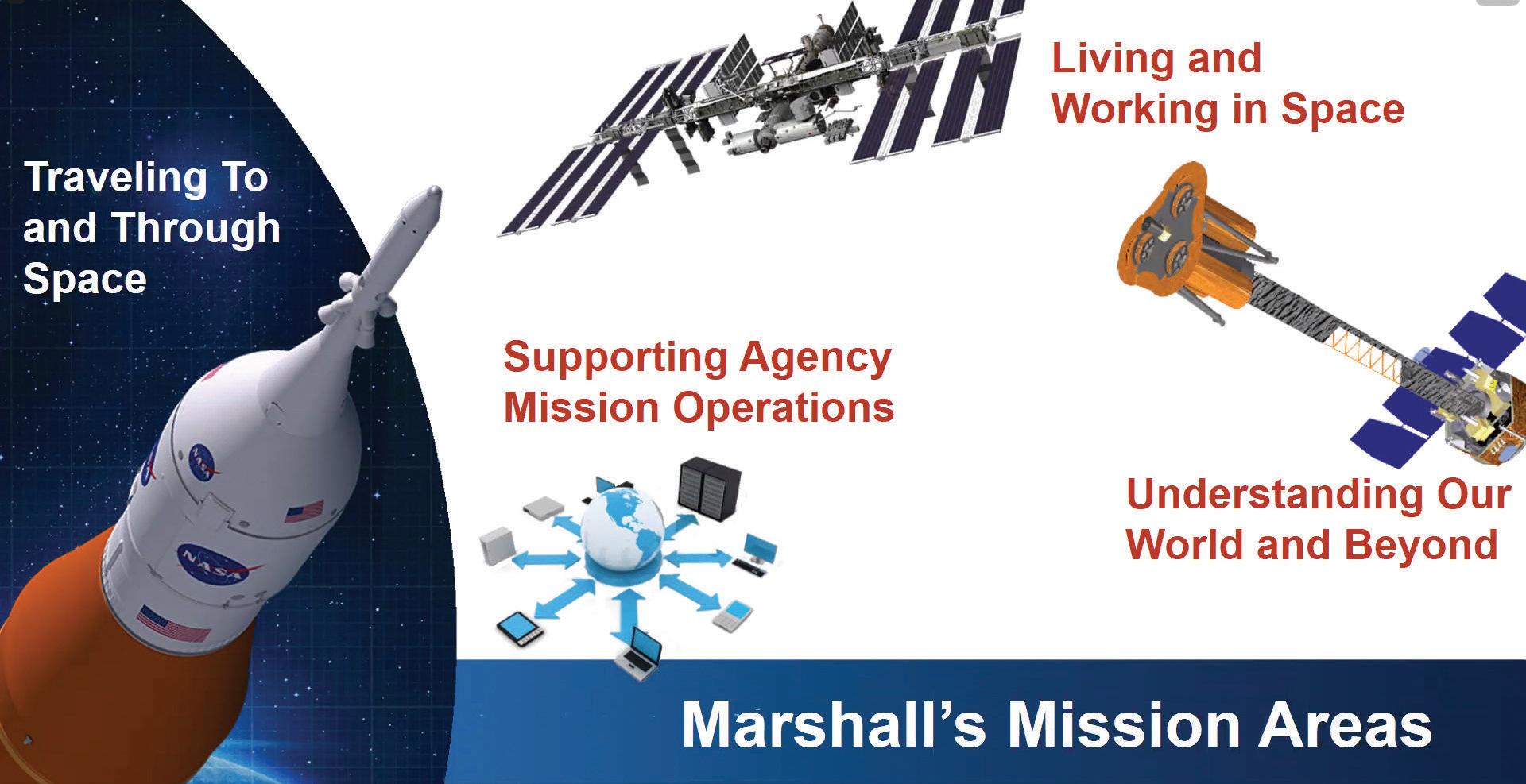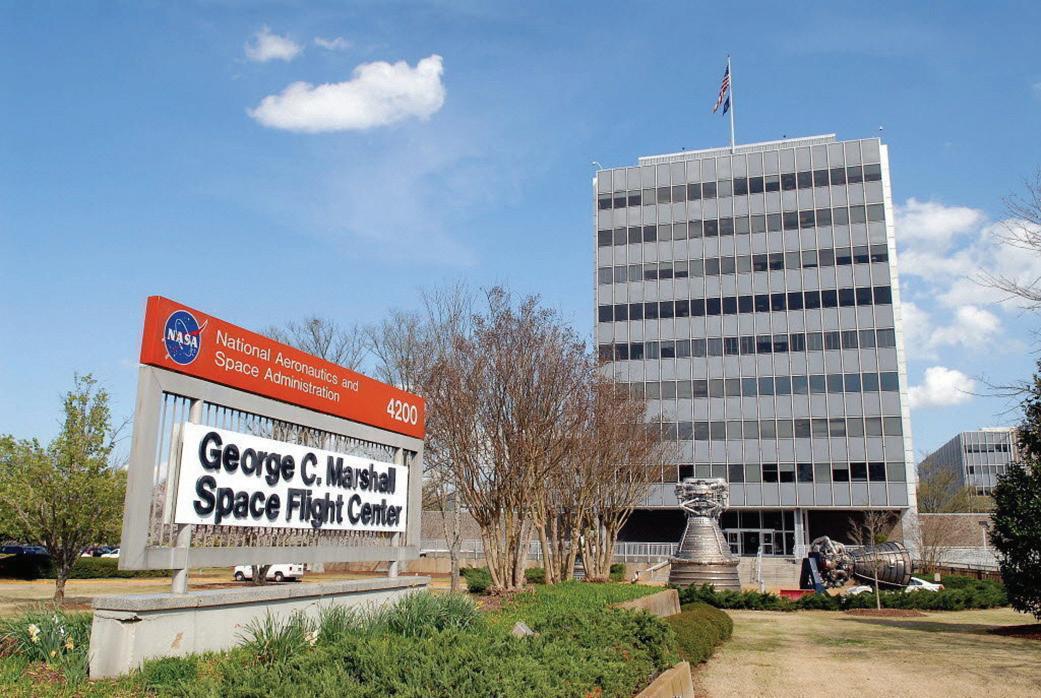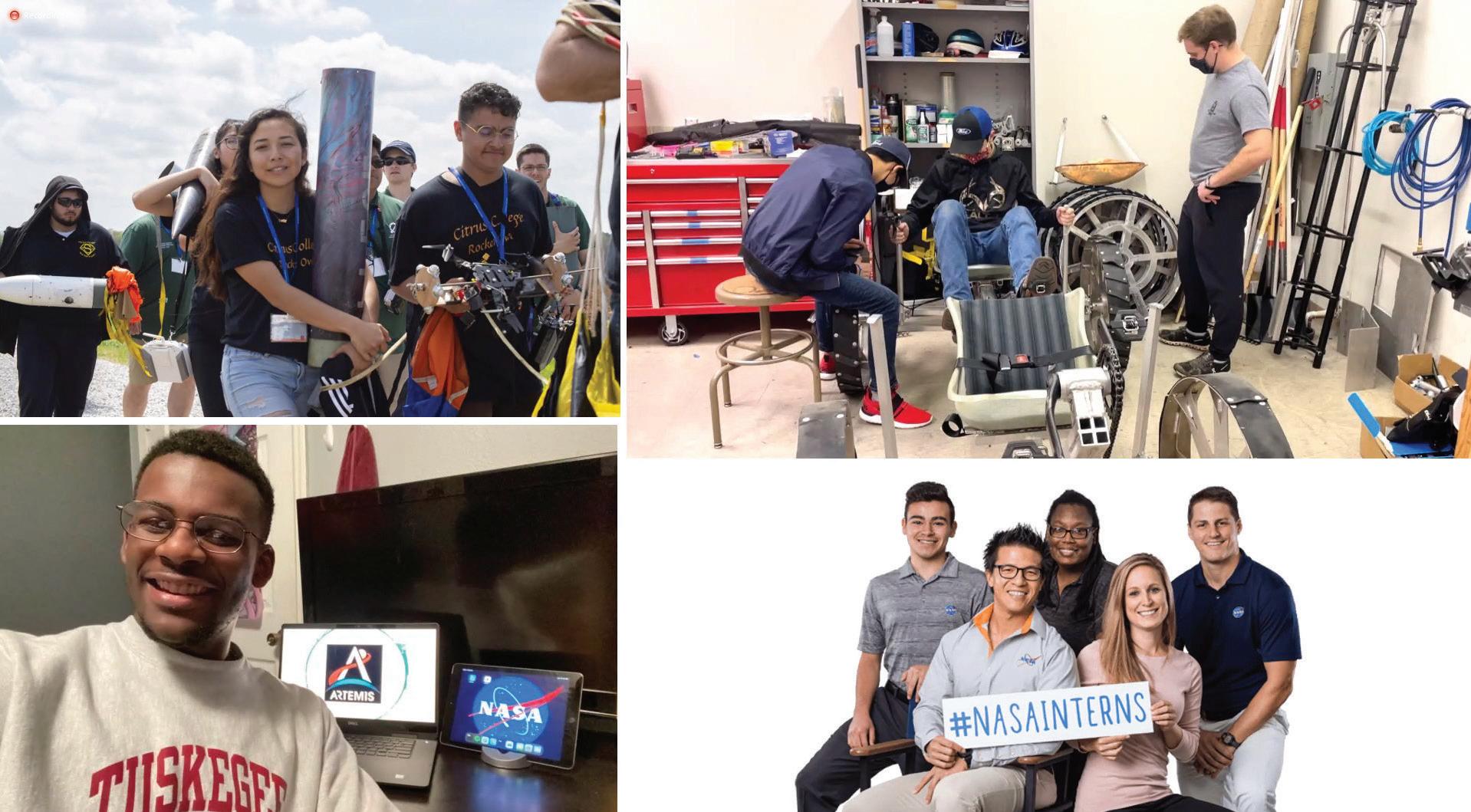
23 minute read
By Lori J. Connors
from HBJ Jul 2021
HudsonAlpha Scientists Identify Genes Involved in Chemotherapy Resistance in Pancreatic Cancer
By Lori J. Connors / Photo courtesy of HudsonAlpha
Advertisement
Imagine a world where science can unlock the mystery of cancer cells that are fighting against the very drugs used to combat its spread.
HudsonAlpha Faculty Investigator Dr. Sara Cooper and her team, in collaboration with the Myers Lab, are focused on discovering genetic bases for chemotherapy resistance in pancreatic cancer to help identify treatment options.
Pancreatic ductal carcinoma, also known as pancreatic adenocarcinoma, is the most common type of pancreatic cancer. PDAC accounts for more than 90% of pancreatic cancer diagnoses.
It is frequently diagnosed in its late stages because symptoms are often vague, mimicking less serious illnesses. For these patients, chemotherapy and radiation are usually their sole course of treatment.
PDAC is also one of the most lethal cancers, with an average of less than 10% survival rate after five years. This low survival rate can partly be attributed to chemotherapy resistance.
Cooper and her lab recently published a paper in BMC Cancer that describes the results of the study, which identified genes involved in resistance to chemotherapy.
Using CRISPR DNA editing, Cooper and her team of Emily Gordon, Drew Hardigan, and Ryne Ramaker applied this technology to activate and knock out genes in the pancreatic cancer cell lines. Four CRISPR activation and knockout screens were performed. These screens were used to identify genes that could alter sensitivity to the four most common chemotherapies used to treat pancreatic cancer. Widespread closed chromatin has been previously associated with poor prognosis in pancreatic cancer patients and was one of the most consistent mechanisms of drug resistance identified in the screens.
Activation of chromatin remodeling pathways, which is the dynamic modification of tightly wound DNA from its closed state to an open state, allows access to the machinery necessary to turn genes on.
The team then focused on a gene that codes for an enzyme called histone deacetylase 1 (HDAC1) that is involved in chromatin remodeling.
High expression of HDAC1 is also associated with poor patient prognosis in pancreatic cancer. By overexpressing HDAC1 in cell lines, the team discovered that it regulated genes that are part of the epithelial-to-mesenchymal transition, a pathway known to be involved in multidrug resistance.
By predicting a patient’s response to treatment, a physician can avoid administering a medication that has the potential to be ineffective. For example, if a patient’s tumor expressed high levels of a gene implicated in gemcitabine resistance, then the doctor could prescribe a different treatment regimen.
“The ultimate goal in cancer treatment is to prescribe patients a treatment that will work to eliminate their cancer with minimal side effects,” said Cooper. “Now that we have narrowed in on HDAC1 and its involvement in drug resistance, we hope to look at all the genes that are regulated by HDAC1 to see if one or a small subset of them are driving the resistance.” u


MSFC Director Pleased with Fiscal Year 2021 NASA Budget
By Kimberly Ballard / Photos/Graphics courtesy of Marshall Space Flight Center
With the release of President Biden’s fiscal year 2021 appropriation, NASA's budget increased 3 percent to $23.3 billion, with most of the additional funding allocated to its human exploration directorate.
Although the increase is short of the Trump Administration's $25.2 billion aimed at landing astronauts on the moon in 2024, Marshall Space Flight Center Director Jody Singer said she is pleased with the bipartisan approach on moon to Mars.
Singer also said the request provides NASA with the resources to continue the Marshall Center's four main areas of focus: Traveling through and to space with an emphasis on cheating gravity; living and working in space, concentrating on the work performed here in Huntsville on the International Space Station and its commercial crew; understanding our world and beyond centered on the technology needed in the science world; and supporting agency mission operations, including science and information technology.
Singer has been on a whirlwind tour in the weeks leading up to the budget rollout speaking to the 2021 Tennessee Valley Corridor National Summit, and to the Army Additive Manufacturing Summit in Auburn. She met with congressional representatives at the Michoud Assembly Facility in New Orleans where she updated U.S. Sen. Jerry Moran of Kansas, who is on the Senate Appropriations Committee, about the Marshall Center's work with the Artemis I four-stage hardware.
And she went to NASA headquarters in Washington to meet with new NASA Administrator Bill Nelson and Associate Administrator Robert Cabana concerning the 2021 budget rollout.
“We have a very diverse engineering workforce that supports all areas in human exploration, science technology and information technology and that is a critical part of the budget,” said Singer. “Marshall Space Flight Center will be moving to stage II in the NASA framework, which is our return to working onsite. Over 75 percent of us have been working from home … which means we were only turning on mission critical work (during COVID), but we can now turn on more work as people need to be onsite to do their jobs.
“Despite these setbacks, we are still seeing a lot of progress, especially since we delivered the Artemis I’s 4-stage hardware to Kennedy Space Flight Center. While both teams here in Huntsville and the teams at Kennedy are excited, there is still plenty of work to do on the Artemis II, Artemis III, and Artemis IV hardware being Block 1B in the budget.
According to NASA Authorization Act of 2010, the goal of expanding permanent human presence beyond low-Earth orbit requires the development of the Orion crew capsule and the heavylift Space Launch System. Orion will return to Earth at the end of each Artemis mission to be reused.
The SLS, however, is an expendable rocket designed to carry Orion into space and set it on its initial trajectory. The SLS could potentially be used for other missions involving heavy payloads or requiring high thrust. But to do this, it is designed to be upgraded in stages known as Block 1, Block 1B, and Block 2.
NASA is developing Block 1B to replace the Block 1 upper stage and funding it is a major component of the four Artemis missions. Artemis I is being processed at the Vertical Assembly Building at Kennedy and assembly begins this week. Singer said it will take two to three weeks to get it fully integrated and stacked, but it is still slated to launch by year’s end.
“We have delivered our hardware and we’re ready to go,” said Singer. “This will be a significant event this year, and then continued cadence.”
Also in the budget is the Human Landing System Program and Marshall is the designated program lead for the project.
Three contractors - SpaceX, Blue Origin and Dynetics - presented their configurations for the first Artemis launch and landing on the moon some time in 2024. SpaceX was selected, but Blue Origin and Dynetics protested NASA’s decision to the Government Accountability Office.
While that puts the program in a pause over the summer while the GAO adjudicates it, Singer said it will not stop MSFC from moving forward with a parallel contract for sustained services.
“We are supposed to be getting a reading on the protests in the early August timeframe, but in the meantime, we are working a contract for sustained services that is really the foundation that will set all the different systems we get on the surface of the moon,” she said. “It is the ability to deliver multiple systems to the surface of the moon, and that is very critical.”
In the budgetary area of Understanding Our World and Beyond with a focus on the science and technology world, Singer said


MSFC’s payload operations is continuing to work 24/7/365.
“We now have seven astronauts and cosmonauts who have completed the largest and longest duration crew mission in this outpost, and there has been a record amount of activity,” Singer said. “But we’ve had a lot of science going on to deliver on one of MSFC’s upcoming missions - the Imaging X-ray Polarimetry Explorer experiment, looking at the dark holes in our universe. We look forward to that being launched later this year or early next year.”
According to NASA, their partnership with Italy's space agency paves the way for the IXPE breakthrough mission to explore some of the most turbulent and extreme environments in our universe, from the hottest, messiest star factories to violent jets screaming away from monster black holes.
Singer said the 2021 budget also includes STEM engagement activity including the recent Student Launch Competition and a virtual version of the annual NASA Human Exploration Rover Challenge.
And the budget supports a team of 106 summer interns who will work at MSFC through August.
“These people are really a pipeline and a feeder for our future workforce,” Singer said. “Sustained funding and sustained progress. Our legacy is our people, but to keep a legacy for our people, you have to have pipelines of engagement.
“We need to make sure we have the right skills, the right workforce, and the ability to attract and retain a good diverse workforce, and the Huntsville community does that.
“But specific to MSFC, we must have a federal budget that supports us on SLS and the evolution of SLS, landing services, a habitat, a transportation habitat, environmental life controls systems, and that brings about a lot of the technologies we need to go not only to the moon, but on to Mars.
“Sustained services are critical to this and the continued work we do on payload operations, on the ISS, and not just the ISS. It also applies to us moving towards deep habitat systems and a continuous turning on of the next systems needed to explore the surface of the moon and to go on to Mars.
“And these involve additive manufacturing, nuclear propulsion systems, and a lot of technology maturation. We have all of that here in the Huntsville community.” u


Bob Jones Alum Candice Storey Lee Opening ‘Dores to Finance
By Mike Easterling / Photo courtesy of Vanderbilt University
When Bob Jones High School’s Candice Storey signed a basketball scholarship with Vanderbilt University, she figured to move on from Nashville once her eligibility was exhausted and her degree was secured.
After all, relocating was a way of life as a military family member. She attended 12 schools before entering the ninth grade with the Patriots.
“I had moved so much that when I came to Nashville, I think my initial thought was I’ll be here for four years and then I’ll head back home because like every four or five years or so that’s what we did, we moved,’’ she said.
It didn’t turn out that way.
Storey Lee has called Nashville home since she arrived in 1996, joining the athletic department in various positions after her playing days plagued by knee injuries were over.
She’s earned three degrees from Vanderbilt, including a master’s and a doctorate in higher education administration, and is also making history.
In early February 2020, she was named the school’s first female athletic director as well as the first black woman to hold that position at a Southeastern Conference school.
That was on an interim basis. She was later named to the job full-time on May 21, 2020. In addition to her AD role, Storey Lee also holds the title of vice chancellor for athletics and university affairs.
“Instead (of moving on), I pleasantly found a place where I could put down my own roots and it just felt perfect, it feels perfect, and in so many ways’’ said Storey Lee, who had risen to associate AD in 2016 on her way to the top job. “I'm not far from my (parents, retired in Madison). I am in a city that I love, I get to be at my alma mater and it's just like it's a dream come true and, no, I did not imagine that would be the case.’’
When Storey Lee was named AD she joined Virginia’s Carla Williams as the only two black women running athletic departments at Power Five schools. That number grew to three when Nina Duke was recently named AD at Duke.
Storey Lee has been busy since moving into her role.
She made head coaching changes in football and women’s basketball and the pandemic began shortly before she took over. She said navigating the virus to keep student-athletes safe has been her biggest challenge, so far.
Though a longtime Commodore, she also felt some pressure of the unknown.
“When you’re inheriting a role, you’re just trying to find your footing and be your authentic self and learn the environment,’’ she said. “I know that that may sound silly, being that I've been at Vanderbilt so long, but I was really intentional about not stepping into the role and assuming that I knew everything I needed to.’’
As a player, Storey Lee earned SEC All-Academic honors and earned four basketball letters but it took six years to get them. She redshirted as a freshman and, during her redshirt senior season, she had another in a string of knee injuries and sat out
Then-Vandy Coach Jim Foster, and the school successfully petitioned the NCAA for a sixth season. When his former player was named AD, he told the Nashville Ledger she was more than capable of handling problems with aging facilities and dwindling attendance.
“If there is, in fact, turmoil and if, in fact, there are problems that need to be solved, the perfect person is now in position to start doing that,” Foster said.
Those issues have been addressed.
Vanderbilt’s first-of-its-kind for the university Vandy United Fund was announced in March -- a $300 million commitment to upgrade facilities and operations. The school has already earmarked $100 million for the project and $100 million has been raised through donors.
The Commodores are renovating existing facilities, building new ones and “adding resources for all of our teams,’’ Storey Lee said.
Among the upgrades are a Football Operations Center, with soon-to-be renovated locker rooms; an indoor football practice field; a Sports Performance Center added to an expanded McGuin Center; a Basketball Operations Center and upgraded amenities at sports venues for the fans.
The football locker rooms should be ready for this season and other projects are expected to begin early in 2022.
Vanderbilt is unique in that it’s the lone SEC private school. It is also its smallest and the only one in a major city. It’s also the highest rated academic institution in the league and among the tops nationally.
Storey Lee says those things, along with the economic infusion, make Vandy an attractive option.
“I was attracted to Vanderbilt because I thought it offered the best of both worlds,’’ she said. “And I still think that, right?’’u


Spur and AMIIC Team Up to Roll Out WorkbasED for High School Interns
By Lori J. Connors
Looking for an internship? There’s an app for that.
This coming school year, area high school students will have the opportunity to participate in paid internships with local businesses.
Spur has recently partnered with the local non-profit Advanced Manufacturing Innovation & Integration Center to roll out workbasED, a work-based learning and internship program geared toward local high school seniors.
Spur and AMIIC will be working with Huntsville City Schools, Madison City Schools, and Madison County Schools, along with bringing industry partners on board. WorkbasED is scheduled to roll out in early August.
WorkbasED, powered by Spur, promises to be North Alabama’s most collaborative work-based learning initiative to date. Collaborators will combine an academic and workforce preparedness curriculum with technical training. This helps to better prepare students for relevant, hands-on experience.
The Spur-AMIIC partnership will provide students with the chance to connect with employers. It also will serve to provide workplace partners with an opportunity to shape the future of their workforce.
“We’re working together to create a talent pipeline for employers across industries geared toward direct employment after high school graduation,” said Christy Beck, Spur’s senior workforce strategist. “WorkbasED works for students, too. Our student interns receive hands-on work experience and pre-employment soft skills training that leaves a lasting impression upon their employment candidacy as they prepare to enter the workforce.”
WorkbasED supports a range of disciplines and industries including engineering and manufacturing. Additionally, workbasED’s onboarding platform powered by Spur facilitates the delivery of prerequisite workforce preparedness modules, such as business professionalism, communication skills, workplace etiquette, and more.
The application process, onboarding, and training modules will all be delivered seamlessly by Spur. All that’s required is the desire, interest, and a smartphone.
“Building a predictable workforce pipeline is a community effort and workbasED brings all stakeholders together, including our students, where meaningful conversations around career development, simulated work experiences, and financial literacy are taking place,” said John Schmitt, executive director of AMIIC. “The program is complemented by Spur’s proprietary software which provides an end-to-end user experience from the time students apply to payday.”
Workplaces interested in providing paid work-based learning positions to high school seniors are invited to join workbasED’s waiting list. Interested workplaces are encouraged to join the waiting list by July 1 to prepare for fall student intern placement.
In August, workbasED will work with schools and workplaces to begin filling paid internships positions.
Students are encouraged to speak with their school counselor or career tech program director to discuss the opportunity. Fall internship opportunities will be posted and open to student applicants in August.
For more information:
Students - https://www. workbasedworks.com/
Prospective Employers - https:// www.workbasedworks.com/i-am-aworkplace
Spur - https://spurstaffing.com
AMIIC - https://amiic.us. u


For the last several years, rumors about plans to develop the former site of the Coca-Cola bottling plant downtown flew through Huntsville.
Now, the city and a developer can put those rumors to rest.
Last month, the City Council unanimously approved plans for a $325 million mixed-use development on the 13-acre property on Clinton Avenue across from the Von Braun Center.
The approval is just the first step in a partnership between Huntsville and New York City-based Rocket Development Partners. Huntsville will contribute $18 million toward the project, but not until the Rocket Development team has started and/ or completed its commitments. Rocket Development Partners is a joint venture between Essex Capital Partners and AscendAmerica.
“Our team is energized by Huntsville’s growth, and we are excited to support Mayor Tommy Battle’s master plan with a transformative downtown project that will meet the city’s rising needs and serve as an engine to the future of city building on a national scale,” said Essex Capital CEO Mitchell Rutter. “Mayor Battle is committed to smart growth and we’re grateful to him, his team and community partners for creating a city where people and businesses of all backgrounds can thrive.”
The first phase would include 26,000 square feet of retail space, 40,000 square feet of office space, a 100-room hotel and multifamily housing. Also included is an 800-space, multilevel parking garage, open space and a surface parking lot.
General site work would be completed by July 2022, followed by the start of construction on the multifamily buildings, retail space, and surface parking lot.
Hotel construction is anticipated to wrap up in June 2025, while office spaces and the parking garage would be completed by September 2025.
Rutter and Dan Shields, president and founder of AscendAmerica, said they believe Huntsville is on a fast track to becoming Alabama's biggest city with a downtown master plan that envisions bringing a unique mix of residential, retail, office, and entertainment to meet the demands of pedestrians, public transit, streetscaping and connectivity with the Von Braun Center.
Because the new project is within an Opportunity Zone, Rocket Development is investing in a distressed area to help spur economic growth and job creation. Rutter and Shields see the project as helping to create a vibrant live, work, play atmosphere downtown, while expanding the local economy for decades to come.
“Our team looks forward to playing a role in Huntsville’s next phase of growth with this mixed-use development,” said Rutter. “There is a lot of work to do ahead but we expect to announce more details about the project in the coming weeks.”
In a presentation to the City Council last month, Shane Davis, Huntsville’s director of Urban & Economic Development, estimated the city’s return on investment would be $25.4 million over a 10-year period.
The plant, officially called Big Springs Bottling, closed in 2012 and was demolished two years later.
“This is a great opportunity to turn vacant property into new and unique places for people to eat, shop, stay the night and live,” Battle said. “It’s an exciting project that will attract citizens and visitors alike, which will benefit Huntsville for years to come.”
Davis said the project would be a mixed-use development completed in multiple phases. The overall design of the first phase is expected to wrap up this summer, according to the city.
As part of the development agreement, Rocket Development Partners would be responsible for all construction and donate property to the city for right-of-way and easements. It would also provide a 50-year lease agreement to Huntsville for 400 spaces within the 800-space garage. The developer would also be responsible for all upkeep and maintenance of the garage, the city said.
“Huntsville is blessed with triangulating factors: job growth with good wages, population growth, and the leadership team,”



Rutter said. “They have a long-term Huntsville vision. That long-term plan, which includes the Von Braun Center expansion, renovation of Pinhook Creek, greenways and bikeways, is geared to accelerate the growth of downtown.”
Rutter said his company has retained Huntsville architect Paul Matheny and Urban Design Associates, who developed the city’s long-term plan.
For its part, the city would be responsible for completing downtown streetscape improvements along Clinton and Holmes avenues and Monroe Street. The city said it would also vacate the Pollard Street right of way that bisects the property.
Huntsville would be required to build a road connecting Clinton and Holmes avenues that would parallel Pinhook Creek and the proposed downtown Riverwalk project.
The city began working the project in late 2019. Because of the size and scope of the development, Davis said, it took time to put it together in a correct format that would provide long-term quality to the Central Business District.
He said it has been “critically important” to ensure the redevelopment of the property complements the adjacent public venues and is built to a quality standard.
“I believe being able to keep the project moving forward and the committed private investment says a lot about the strength of the Huntsville economy,” Davis said. “Creating of thousands of new jobs and our commitment on infrastructure investments continue to pay dividends in new private investments.
“We are confident this trend will continue in downtown and across all parts of Huntsville.” u


Along with ‘Rocket City’, ‘Championship City’ Has Nice Ring to It
By Mike Easterling
Green Bay took on the nickname "Titletown" in the wake of the Packers’ early NFL success. "City of Champions" has been adopted by the likes of Boston and Pittsburgh. Now comes, perhaps, the Championship City?
While Huntsville will always be known as the Rocket City, the recent attraction of championship-caliber events has led to unprecedented sports tourism dollars in the area this year to the tune of more than $10 million.
And we're barely halfway through 2021!
There have been the Korn Ferry Golf Tour’s Huntsville Championship, the Southeastern Conference Gymnastics Championship, the Coastal Collegiate Sports Association Beach Volleyball Championships, the U.S. Paralympics Cycling Open and the Southwestern Athletic Conference Baseball Championship.
In 2021 those events joined existing ones unfolding in the Huntsville area such as the Alabama High School Athletic Association’s soccer state championships.
Among the events the city was to host are the United States Tennis Association’s 3.0-4.0 State Championships last month at the Huntsville Tennis Center, the recent Alabama Junior Golf Association’s Huntsville Open at Huntsville Country Club and the USA Swimming Futures Championships July 28-31 at the Aquatic Center,

more of their championship and special events,” said Mark Russell, director of the Huntsville Sports Commission.
“Huntsville has excellent facilities including the Von Braun Center, Huntsville Aquatics Center, John Hunt Park Cross Country Course, Sand Volleyball Complex, Soccer Complex and the underconstruction Joe Davis Stadium. All are championship quality and provide a great setting for competition.’’
Russell and Mark McCarter, the convention sales manager at the Huntsville-Madison County Convention and Visitors Bureau, said teamwork in various offices have led to sports tourism growth.
“It’s just a testament to city leaders, elected officials that have led the way to build facilities where we can still easily host these events (when others couldn’t),’’ McCarter said.
According to Russell, one main target moving forward is college basketball.
“We feel that with the development around the VBC, we will be an ideal city to host a conference basketball championship in the near future,’’ he said. “It’s time for us to think big and compete with any city for these signature events.’’
Before the beach volleyball championships, Huntsville Mayor Tommy Battle said, “Like the spirited and dedicated top-tier athletes who will compete in the Rocket City, we are going above and beyond by providing world-class facilities and hospitality. “We want everyone to know Huntsville is where champions come to play.” Madison Mayor Paul Finley, whose city is the home of the Minor League Baseball Rocket City Trash Pandas and Toyota Field, emphasized unity is the key to success to hosting the big events. The SWAC moved its baseball tournament to Madison this year from its long run in the New Orleans area. .
“We’re stronger when we work together,” he said. “We’re going to get all the events we can. This community continues to be set up for success.’’ u





